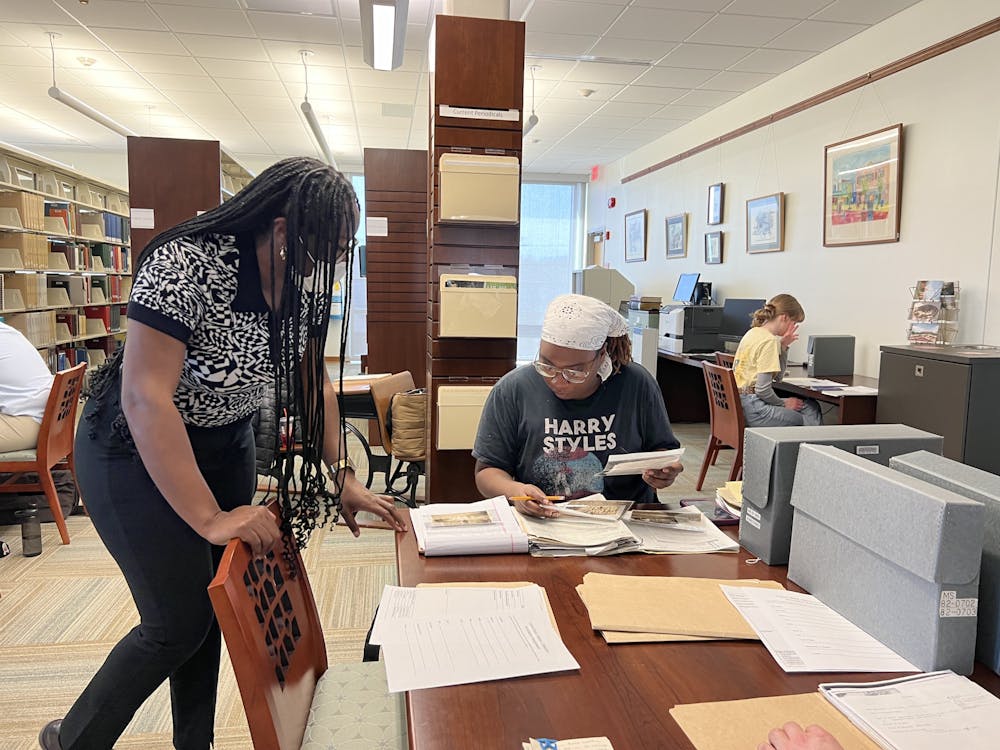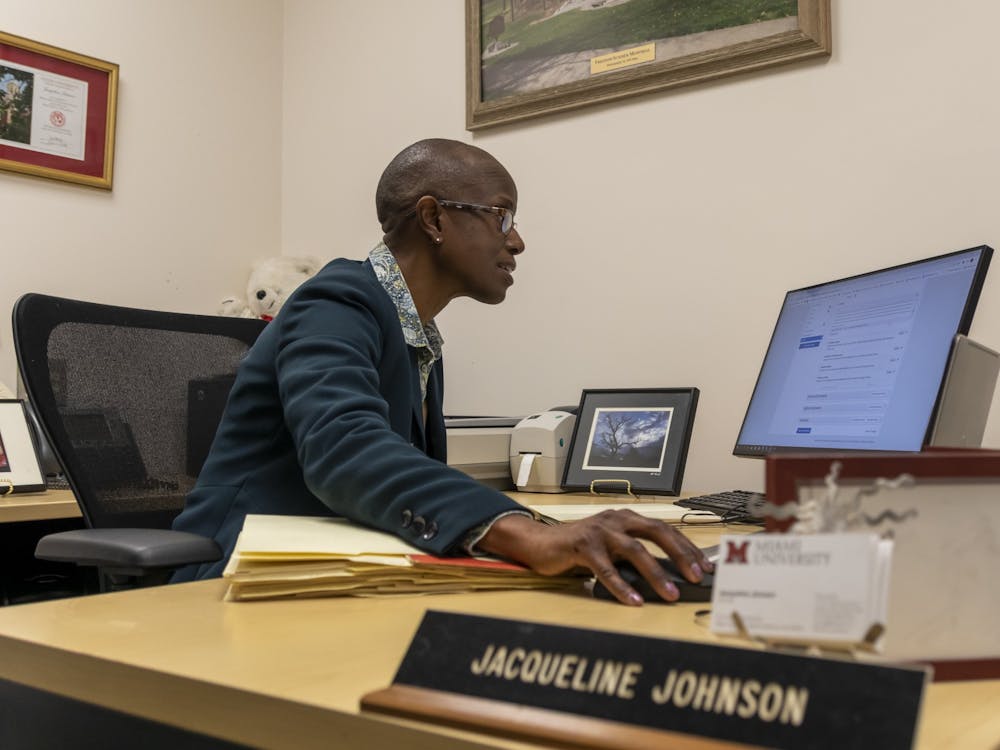Helen Kiss sits down with faculty, staff and students at Miami University every day to sift through thousands of databases that hold information about research grants.
Kiss' work as assistant director at the Office for the Advancement of Research and Scholarship links Miami researchers with funding sources on the national, state and private levels.
"It's sort of like a treasure hunt," Kiss said. "You're trying to find a pot of money."
As Kiss explained the details of her job, her computer screen unfreezes to reveal a virtual jigsaw puzzle she enjoys working on in her spare time. Finding funding is like fitting the pieces of a complex puzzle together until the prize is revealed.
Bills from D.C.
The pot of money for research just got bigger. Congress passed the American Recovery and Reinvestment Act in February 2009 at the urging of President Barack Obama. The Recovery Act is a stimulus program in direct response to the current economic crisis.
So far, Miami has been awarded about $4 million, and the Recovery Act intends to eventually distribute $275 billion for federal contracts, grants and loans.
Universities across the country, including Miami, will be on the receiving end.
Federal money is the single largest contributor to university research. During 2008 at Miami, 64 percent of academic grants and contracts came from federal sources. This amounted to more than $14.4 million.
In terms of receiving stimulus grant money, the competition is high.
"We aren't MIT or Harvard, but it all comes back to the idea," Kiss said.
Enjoy what you're reading?
Signup for our newsletter
Miami research
Generating ideas is exactly what Miami faculty members, like Craig Williamson, are working toward.
Williamson is a zoology professor who came to Miami in June 2005 as a recipient of the Ohio Board of Regents Eminent Scholar Program. Eminent Scholars are established researchers whose role is to serve as leaders in research on campus and in Ohio. Williamson is one of just two recipients at Miami.
Of the $4 million already awarded to Miami from the Recovery Act, Williamson has gotten more than $1 million. The money comes from a National Science Foundation program called IGERT - Integrative Graduate Education and Research Traineeship.
Williamson's research focuses on threats to water quantity and quality. He currently works in conjunction with Kent State University, a research partnership Kiss recognizes as becoming more and more popular.
"A lot of agencies want to see more partnering," Kiss said. "It is not unusual for Miami to join with other institutions such as Indiana
University, Ohio State and the University of Kentucky. With the Internet, it doesn't really matter where anyone is anymore."
Williamson sees water quality as one of the most important issues on the regional, national and global levels. Maintaining a healthy water supply is a constant challenge, Williamson said.
His answer to discovering and documenting changes in the water supply is sensors.
Part of the Recovery Act money will go toward purchasing recently developed sensors that will detect even the most sensitive changes in water composition.
The sensors will be put into Acton Lake in Hueston Woods State Park and will relay information back to the researchers. The information would be available to current students.
"Undergraduates can sign into their computers and see what has been going on," Williamson said.
The rest of the stimulus money will go toward supporting graduate students in the field and, potentially, for developing an aquatics and watershed research center. Such an addition would likely establish aquatics research as an area of expertise at Miami and possibly attract more grant money in the future.
Breaking out of the classroom
This particular allotment of stimulus money won't go directly toward supporting undergraduate research but Williamson stresses undergraduates as a fundamental part of the research process.
Each summer, Williamson brings undergraduate students to lakes far from Ohio to gather data and become directly involved in the research experience.
Cody Green, a senior zoology major, traveled to Glacier National Park in Montana with Williamson last summer for two weeks.
"Although the field work was strenuous, it was the most beautiful place I have ever seen," Green said. "The research that I conducted gave me the chance to go somewhere I would not have normally gone. It was the best part of my research, and by far the best part of my summer."
Green conducted research through the Undergraduate Summer Scholars program (USS) at Miami.
The program provides Miami sophomores and juniors with individual faculty mentorship in a research project often of their own choosing.
"With the help of Dr. Williamson, I created a hypothesis that was a missing piece in a research project conducted by both Miami University and the University of Maine," Green said.
His results were a large contribution to the joint research conducted by the two universities.
Green said it was an invaluable experience.
"I was given the opportunity to study and create a project no one else in the world had ever done, and I had to jump at the opportunity," Green said.
Mike Cohen, a senior zoology and environmental science double major, was also involved in aquatics research with Williamson. Cohen traveled to Lake Tahoe and the Poconos Mountains in Pennsylvania in summer 2008.
"Doing research as an undergraduate has provided me with skills that I can take to other professions such as careful detailing of results and setting up proposals and experiments," Cohen said. "If I decide to work in the sciences, I have a skill set that employers are looking for."
Williamson said Miami is creating a dynamic environment for undergraduates through the opportunity of independent research.
"Research is the crown jewel of education," Williamson said. "A lot of people think they are opposed to each other, but research is the ultimate type of inquiry-based learning."
Williamson said he believes course work provides the fundamental skills needed in acquiring an education, but research provides a uniquely meaningful experience.
Green said he agreed.
"Not only does it show that you have the patience and self-dedication to create your own hypothesis and test it," Green said. "But it challenges your mind unlike any undergraduate course you can take at Miami."
James Brock, an economics professor, said he supports research endeavors at Miami but is concerned the university has moved further away from an emphasis on undergraduate education in the past decade.
"Undergraduate teaching loads are being reduced, making classes bigger and the quality of intellectual engagement between faculty and students suffers," Brock said.
Brock said a shift in time spent conducting research rather than teaching may also cause students to not be able to register for classes required for their major.
Brock stressed that research and undergraduate education should enhance one another, and a focus on research should not detract from the quality of undergraduate education a student receives.
More Benjamins to come
James Oris, associate dean for research and scholarship at Miami, estimates about $6 to $7 million of federal stimulus money for research by Miami students and faculty is waiting to be accepted. That National Science Foundation has been the largest source of federal research money since 2006.
Fluctuations in the amount of funding received each year are normal and there are explanations for yearly increases and decreases.
The 2008-09 fiscal year saw a decrease in the amount of federal funding for research, but Oris attributed this to the economy and the fact that it was an election year.
"Right now there's a lot of money with Obama," Kiss said. "But next year, you never know."
Last year, Miami received more than $17.4 million in federal funding for academic grants and contracts, an increase of more than $3 million compared to this year. Large research institutions such as Ohio State received approximately $335.1 million in 2008. Ohio University received about $29.6 million.
Currently, federal funding for research seems to be on the rise. According to Kiss, this may mean a couple things.
"We are going to see more money, more deadlines, and more opportunities," Kiss said. "The merit of the research is still going to be judged with a fine-toothed comb."
In addition to USS, Miami is now offering a research program for first-year students called the First Year Research Experiences in an effort to link undergraduates with faculty to conduct research early in their college careers. Research opportunities for teams of undergraduates are also available.
Visit the Office for the Advancement of Research and Scholarship Web site at http://www.units.muohio.edu/oars to view opportunities and application deadlines. Grants for research are offered in almost every major and field.
"It's the difference between going to McDonald's and getting fast food that will fill you up and going to an international smorgasbord and saying,'What would you like to try?'" Williamson said. "That is the magic to it to some extent."



